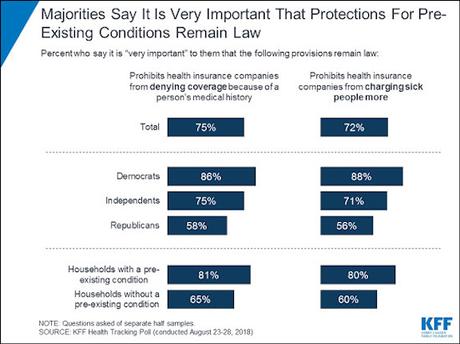
The chart above is from a Kaiser Family Foundation survey done last August, but I think little has changed. The American public knows that Obamacare (Affordable Care Act) did not solve all the ills of our health care system. But they also think that it made some progress toward that -- especially in eliminating the pre-existing conditions that had insurance charging more or even denying coverage because of them. And they know that abolishing Obamacare without a sufficient replacement will destroy that (and cause millions of Americans to lose their health insurance).
Much remains to be done to fix our health care system, and abolishing Obamacare won't fix that. This is especially true because the Republicans, after 9 years of trying, have been unable to come up with a plan they can even get their own party to agree on. How bad is the current system? Consider these facts:
* Americans borrowed about $88 billion last year to pay for health care.
* Americans spent $126 billion of their savings last year to pay for health care.
* One-third of Americans worry that a medical emergency would force them into bankruptcy.
* About one-quarter of Americans deferred health care treatment last year because of cost (including 27% of Democrats, 21% of Republicans, and 30% of Independents).
* The current system still leaves millions of Americans without health insurance (especially in red states that have refused to expand Medicaid).
Obviously, something must be done. Democrats want to either go to a single-payer system (Medicare For All), or fix the current system and include a public option (that people could buy into). Both are good ideas, and better than what we have now.
Republicans want to abolish Obamacare, without having anything to replace it. Trump has said the Republicans would produce a better plan after Obamacare is abolished, but that's just another lie. In spite of their inability to agree on a plan, no plan they have proposed would improve on Obamacare. All of them would be a step backward, and hurt millions of Americans.
Trump does not have a plan either, but if you look at the budget proposal he recently submitted, you can see what kind of plan he wants. Here's what that is:
Last month, the Trump administration released its annual budget — a 148-page document that spells out the type of policies that it would like to become law. In that budget, the White House says it supports “enactment of legislation modeled after the Graham-Cassidy-Heller-Johnson bill proposed in September 2017.”
This is helpful because it gives us a clear picture of what the Trump administration actuallywants to see changed in our health care system. We can read the bill that the budget administration references right here and dive into policy briefs that explain how it would work.
Graham-Cassidy-Heller-Johnson (which I’ll shorten as Graham-Cassidy) was a plan put forward at the very end of the Republicans’ health care push in 2017. It would repeal the Affordable Care Act entirely, including consumer protections preexisting conditions and an expansion of Medicaid, that gave millions of low-income Americans coverage. The Obamacare subsidies that 8.8 million Americans use to purchase private coverage on the health law’s marketplaces would cease to exist.
The rules around private insurance would change a lot, in a way that is much less friendly to sicker Americans. The mandate that private Obamacare patients not be charged for preventive care visits would go away. Current limits on out-of-pocket spending for Obamacare enrollees would be abolished too, a change that could be especially challenging for those with costly medical conditions.
In Obamacare’s place, Graham-Cassidy would create something it calls a Health Care Grant Program, which would give states a lump-sum to fund its health care programs. States would also have the option to allow insurers to charge sicker people higher premiums. They could let insurers set higher prices for pregnant women, too (this was common practice before the Affordable Care Act). States could let insurers opt out of Obamacare’s essential health benefits requirements, which currently mandate that health plan cover a core set of services including prescription drugs and maternity care.
States that like Obamacare couldtry and keep the system running, using the money from their new health care grants. They could keep requiring insurers to charge sick people the same premiums as healthy people, keep the essential benefits package in place, and try to pay for their Medicaid expansion.
But they’ll probably find that quite difficult, because Graham-Cassidy would cut spending on these programs significantly. The Congressional Budget Office analyzed Graham-Cassidy shortly after its introduction. Their report estimates that the legislation would, over a decade, spend $230 billion less on health coverage programs than the Affordable Care Act.
Some states “would find it particularly challenging to reach current enrollment levels using the available subsidies,” CBO concludes.
That sharp cut in funding helps explain why CBO thinks that Graham-Cassidy won’tdeliver on Mulvaney’s promise (speaking for Trump) that Americans won’t lose coverage if Obamacare is repealed.
Instead, the nonpartisan agency determined that “if this legislation was enacted, millions of additional people would be uninsured compared with CBO’s baseline projections.” The increase in uninsured would largely come from rolling back the Medicaid expansion. That program, which covers 61 million Americans and has grown significantly under the Affordable Care Act, would face a $1 trillion budget cut over the course of a decade.

